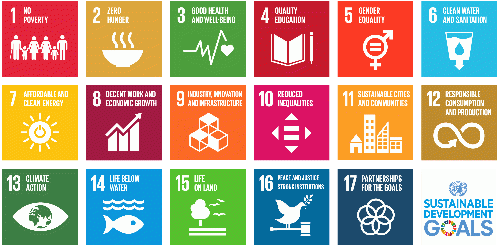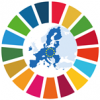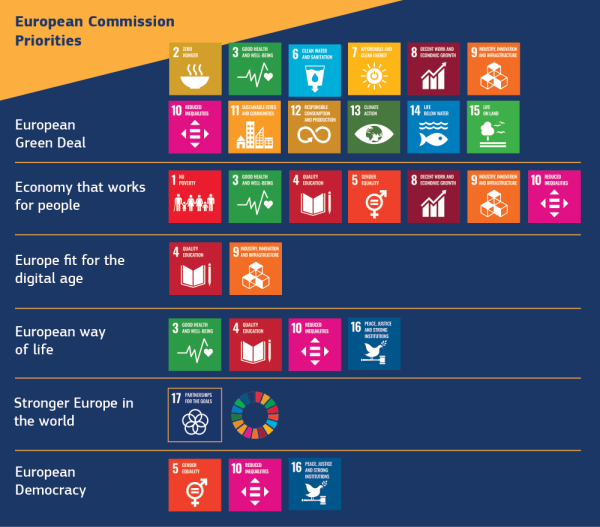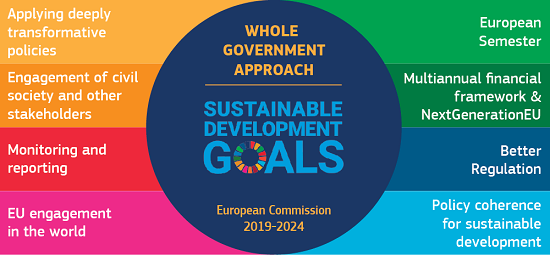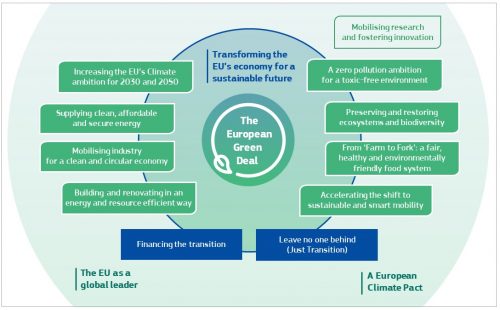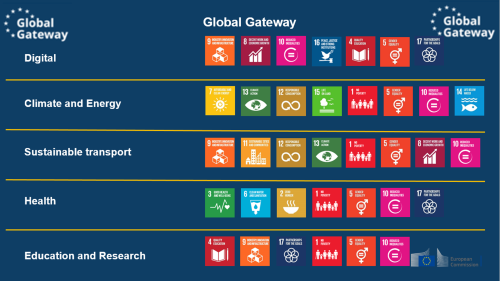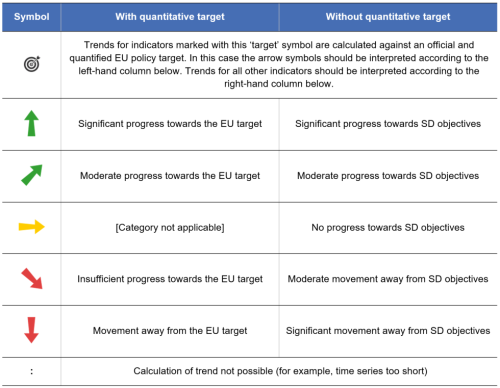SDG - Introduction
Data extracted in April 2023.
Planned article update: June 2024.
Highlights
This article is a part of a set of statistical articles, which are based on the Eurostat publication ’Sustainable development in the European Union — Monitoring report on progress towards the SDGs in an EU context — 2023 edition’. This report is the seventh edition of Eurostat’s series of monitoring reports on sustainable development, which provide a quantitative assessment of progress of the EU towards the SDGs in an EU context.
Full article
About this publication
Sustainable development objectives have been at the heart of European policy-making for a long time, firmly anchored in the European Treaties [1] and a mainstream part of key projects, sectorial policies and initiatives. The 2030 Agenda for Sustainable Development and its 17 Sustainable Development Goals (SDGs), adopted by the United Nations (UN) in September 2015, have given a new impetus to global efforts for achieving sustainable development. The EU and its Member States are committed to this historic global framework agreement and to playing an active role in maximising progress towards the SDGs.
The von der Leyen Commission has made sustainability an overriding political priority for its mandate. All SDGs feature in one or more of the six headline ambitions for Europe announced in the Political Guidelines, making all Commission work streams, policies and strategies conducive to achieving the SDGs. Key elements of the Commission’s ‘whole of government’ approach for delivering on the 2030 Agenda include the design of deeply transformative policies such as the ‘European Green Deal’ and the integration of the SDGs into the European Semester. The European Green Deal aims to transform the Union into a modern, resource-efficient and competitive economy where climate and environmental challenges are addressed and turned into opportunities, while making the transition just and inclusive for all. The Commission’s overall approach towards implementing the SDGs is described in the staff working document (SWD) ‘Delivering on the UN’s Sustainable Development Goals — A comprehensive approach’.
Eurostat supports this approach through regular monitoring and reporting on progress towards the SDGs in an EU context. This publication is the seventh edition of Eurostat’s series of monitoring reports, which provide a quantitative assessment of the EU’s progress towards reaching the SDGs. This publication is based on the EU SDG indicator set, which includes indicators relevant to the EU and enables the monitoring of progress towards the goals in the context of long-term EU policies. It is aligned as far as appropriate with the UN list of global indicators, but it is not completely identical. This allows the EU SDG indicators to focus on monitoring EU policies and on phenomena particularly relevant in a European context.
The Eurostat monitoring report is a key tool for facilitating the coordination of SDG-related policies at both EU and Member State levels. As part of this process, it promotes the ongoing assessment and monitoring of progress in implementing the SDGs, and helps to highlight their cross-cutting nature and the links between them.
This 2023 edition of the EU SDG monitoring report begins with a synopsis of the EU’s overall progress towards the SDGs, followed by a presentation of the policy background at the global and EU levels and the way the SDGs are monitored at EU level. The detailed monitoring results are presented in 17 articles, one for each of the 17 SDGs. This is preceded by an analysis how the recent crises, such as the COVID-19 pandemic and Russia’s invasion of Ukraine, have influenced the EU on its way towards achieving the SDGs, followed by an analysis of spillover effects. The report closes with a ‘country overviews’ chapter on status and progress of EU Member States towards the SDGs. The Annexes contain notes on methods and sources (available in paper format and as a downloadable PDF file).
The 2030 Agenda for Sustainable Development
‘Development which meets the needs of the current generations without compromising the ability of future generations to meet their own needs’. This is the definition of sustainable development that was first introduced in the Brundtland report by the World Commission on Environment and Development (WCED) in 1987, and it is the one most widely used nowadays. Following the Brundtland report were several important milestones in the international pursuit of sustainable development: the Rio Declaration on Environment and Development (1992), the World Summit for Social Development (1995), the Programme of Action of the International Conference on Population and Development (ICPD) (1994), the Beijing Platform for Action (1995), the Millennium Declaration (from which the Millennium Development Goals were derived), the World Summit on Sustainable Development (2002), the 2005 World Summit and the UN Conference on Sustainable Development (Rio+20) in 2012. Together, they paved the way for the 2030 Agenda.
In September 2015, the UN General Assembly (UNGA) adopted the ‘Transforming our world: the 2030 Agenda for Sustainable Development’ document. The 2030 Agenda is the current global sustainable development agenda. At the core of the 2030 Agenda is a list of 17 SDGs (see Figure 1) and 169 related targets to end poverty, protect the planet and ensure prosperity and peace. The Agenda also calls for a revitalised global partnership to ensure its implementation. The SDGs are unprecedented in terms of significance and scope by setting a wide range of economic, social and environmental objectives and calling for action by all countries, regardless of their level of economic development. The Agenda emphasises that strategies for ending poverty and promoting sustainable development for all must go hand-in-hand with actions that address a wider range of social needs and which foster peaceful, just and inclusive societies, protect the environment and help tackle climate change. Although the SDGs are not legally binding, governments are expected to take ownership and establish national frameworks for achieving the 17 goals.
Monitoring of the SDGs takes place at various levels: global, regional, national, local and thematic. The UN High-Level Political Forum (HLPF) is the UN’s central platform to follow up and review the 2030 Agenda and the SDGs at the global level. To this end, the 2030 Agenda encourages UN member states to conduct voluntary national reviews of progress towards the SDGs [2]. Regular reviews by the HLPF are voluntary, state-led, and undertaken by both developed and developing countries. In July 2023, the European Commission will present its first voluntary review, reflecting on the collective effort of the EU and its Member States regarding SDGs implementation. This will be the first time when a voluntary review will be presented not by a country but by a supranational union, such as the EU.
In order to follow up and review the goals and targets, a set of global indicators was designed by an Inter-Agency and Expert Group (IAEG-SDGs) under the supervision of the UN Statistical Commission [3]. In July 2017, the UNGA adopted a global SDG indicator list, including 232 indicators. A comprehensive review of the indicator framework in early 2020 resulted in the approval of 36 major changes to the global SDG indicator list including additions and deletions. Therefore, the revised global indicator framework now consists of 231 indicators. Another such review is planned for 2025.
Every year, the UN releases a Report of the Secretary-General on ‘Progress towards the Sustainable Development Goals’, followed by an SDG report for the broader public. The latter provides an overview of progress on each of the 17 SDGs based on selected indicators from the global indicator framework.
The global indicator framework used to monitor the implementation of the 2030 Agenda is complemented by indicators at the level of UN world regions and at national level. For example, indicator sets have been developed for the Asia-Pacific region, for Africa and for Latin America and the Caribbean. At the European level, the UN Economic Commission for Europe (UNECE) selected 80 indicators from the global list based on relevance for the region and data availability for a newly developed UNECE SDG Dashboard. The UNECE also published a first edition of a Roadmap on Statistics for Sustainable Development Goals in July 2017 and a second edition in February 2022. The latest roadmap aims to provide guidance to members of national statistical systems and other stakeholders on how to best navigate the complex task of measuring the achievement of the 2030 Agenda’s goals and targets. The roadmap covers different aspects such as national coordination, reporting on global SDG indicators, tracking progress at various levels, quality assurance, leave no one behind, communication, Voluntary National Reviews and capacity development. The EU SDG indicator set is in line with the UNECE roadmaps.
Sustainable development in the European Union
Sustainable development is not only a core principle for the European Union but also an overriding political priority for the von der Leyen Commission, which is reflected in the six headline ambitions for Europe announced in the Political Guidelines (see Figure 2) and the investment priority areas of the Global Gateway strategy. Each Commissioner is responsible for ensuring that the policies under his or her oversight reflect the Sustainable Development Goals, while the college of Commissioners is jointly responsible for implementing the 2030 Agenda. The President set out a ‘whole-of-government approach’ towards the implementation of the SDGs (see Figure 3).
Several major policy documents have shaped the EU’s approach to implementing the SDGs. A communication from 2016 ‘Next steps for a sustainable European future: European action for sustainability’ announced the integration of the SDGs into the European policy framework. As a consequence, the EU has been monitoring the implementation of the SDGs since 2017 via annual SDG monitoring reports. In addition, a reflection paper ‘Towards a Sustainable Europe by 2030’ from 2019 highlighted the complex challenges the EU is facing and identified the competitive advantages that implementing the SDGs would offer the EU. Since late 2019, the von der Leyen Commission has presented many transformative policies aimed at delivering on the many aspects of sustainability in the EU and beyond. The EU’s approach for implementing the 2030 Agenda is briefly summarised below and described in detail in a staff working document (SWD) ‘Delivering on the UN’s Sustainable Development Goals — A comprehensive approach’. For a complete overview of the European Commission’s activities related to SDG implementation, see the Commission’s website on the EU’s holistic approach to sustainable development.
The European Green Deal, adopted in December 2019, is the EU’s new growth strategy and aims to transform the Union into a climate neutral society while leaving no one behind (see Figure 4). It aims to create a modern, resource-efficient, competitive and fair economy where there are no net emissions of greenhouse gases by 2050 and where economic growth is decoupled from resource use. It also aims to protect, conserve and enhance the EU's natural capital and to protect the health and well-being of citizens from environment-related risks and impacts. It is also an integral part of the Commission’s strategy to implement the 2030 Agenda and the SDGs.
In March 2020, a new Circular Economy Action Plan was adopted by the European Commission, introducing measures along the entire life cycle of products. The new Plan focuses on design and production for a circular economy, with the aim of ensuring that the resources used are kept in the EU economy for as long as possible.
The EU Bioeconomy Strategy provides a cross-cutting framework to enable transformative innovations with regards to the use of biological resources, and to ensure that the supply of biomass for food and bio-based products fully respects the finite planetary boundaries. A sustainable circular bioeconomy contributes to the European Green Deal objectives, including to climate mitigation through renewable products and energy substituting fossil fuels and other carbon-intensive materials and by contributing to carbon storage in products and ecosystems.
In May 2020, another important initiative that lies at the heart of the European Green Deal was adopted — the Farm to Fork Strategy. The strategy aims to make food systems in the EU fair, healthy and environmentally friendly by ensuring sustainable food production, processing, distribution and consumption and by minimising food loss.
The EU Biodiversity strategy for 2030, also adopted in May 2020 as a part of the Green Deal, aims to put Europe's biodiversity on a path to recovery by 2030, and contains specific actions and commitments, such as establishing a large EU-wide network of protected areas on land and at sea, launching an EU nature-restoration plan and introducing measures to tackle the global biodiversity challenge.
The 2030 Climate Target Plan from September 2020 envisions reductions in greenhouse gas emissions to at least 55 % below their 1990 level by 2030 and sets Europe on a responsible path to becoming climate-neutral by 2050. This ambition was legally enshrined in July 2021 with the adoption of the European Climate Law. Under the heading of ‘Delivering the European Green Deal’, the Commission put forward several legislative proposals, actions and targets for making Europe the first climate-neutral continent. These relate to the necessary transformation of our economies and societies, sustainable transport, clean energy, renovation of buildings, enhancing natural carbon sinks, and boosting global climate action. The Council Recommendation on ensuring a fair transition towards climate neutrality aims to ensure that the Union’s transition towards a climate-neutral and environmentally sustainable economy by 2050 is fair and leaves nobody behind. It sets out specific guidance to help Member States devise and implement policy packages to address the employment and social aspects for promoting a fair transition across all policies, notably climate, energy and environmental policies, as well as for making optimal use of public and private funding.
The Sustainable and Smart Mobility Strategy, adopted in December 2020, lays the foundation for how the EU transport system can achieve its green and digital transformation and become more resilient to future crises.
The Chemicals Strategy for Sustainability published in October 2020 is part of the EU’s zero pollution ambition. The Zero Pollution Action Plan released in May 2021 calls for air, water and soil pollution to be reduced to levels no longer considered harmful to health and natural ecosystems, respecting the boundaries with which the planet can cope, thereby creating a toxic-free environment.
The European Pillar of Social Rights Action Plan outlines concrete actions to further implement the 20 principles of the European Pillar of Social Rights as a joint effort by the Members States and the EU, with the active involvement of social partners and civil society. The revised Social Scoreboard, which is also linked to the SDGs, was presented as part of the Action Plan to monitor progress towards the implementation of the Social Pillar principles within the European Semester. The Action Plan also proposes employment, skills and poverty reduction headline targets for the EU to be achieved by 2030. The new 2030 headline targets are consistent with the UN Sustainable Development Goals and set the common ambition for a strong Social Europe.
Meanwhile, the 2021 update of EU’s new Industrial Strategy supports the twin transition to a green and digital economy. It seeks to ensure that the European industry leads the way in delivering the EU’s goals for a green, inclusive and resilient future. The strategy aims to boost support to the renewable energy and climate transition, while reinforcing the EU’s strategic autonomy. In early 2023, the Commission moreover launched a Green Deal Industrial Plan to enhance the competitiveness of the EU’s net-zero industry and support the transition to climate neutrality. The plan aims to provide a more supportive environment for scaling up the manufacturing capacity of the net-zero technologies and products that are required to meet the EU’s climate targets. The Communication ‘Long-term competitiveness of the EU: looking beyond 2030’ complements the Green Deal Industrial Plan with a long-term and comprehensive approach to the competitiveness of the EU.
Building on the European Green Deal, the 8th Environment Action Programme (EAP), adopted in March 2022, anchors the Member States’ commitment to environmental and climate action until 2030, guided by a long-term vision to 2050 of wellbeing for all, while staying within the planetary boundaries. The 8th EAP has six priority objectives related to climate neutrality, climate adaptation, circular economy, zero pollution, protecting and restoring biodiversity, and reducing environmental and climate pressures related to production and consumption. In addition, the programme sets out an enabling framework and a monitoring framework to measure progress towards the required systemic change.
Over the past few years, the EU has adopted numerous other policies covering topics related to the SDGs. The European Consensus on Development, adopted in 2017, defines the EU’s shared vision and action framework for development cooperation. Global Gateway is the EU’s strategy to support its partner countries in boosting smart, clean and secure links in digital, energy and transport sectors, and to strengthen health, education and research systems. Global Gateway is fully aligned with the 2030 Agenda and the SDGs as well as the Paris Agreement, and brings together the EU, its Member States and their financial and development institutions as Team Europe.
The Team Europe approach was initially launched in early 2020, as a package to support partner countries in the fight against the COVID-19 pandemic and its consequences, and to ensure a co-ordinated and comprehensive response between the EU and its Member States. The approach has quickly become the backbone of Global Europe (the main financial tool for EU international cooperation from 2021 to 2027) and its programming. It notably includes the conception of Team Europe Initiatives, which are the flagships of the Team Europe approach. The European Democracy Action Plan was adopted the same year to empower citizens and build more resilient democracies across the EU.
Furthermore, EU Cohesion Policy, including the European Regional Development Fund (ERDF), the European Social Fund+ (ESF+), the Cohesion Fund and the Just Transition Fund (JTF), is also strongly aligned with the SDGs. It contributes to strengthening economic, social and territorial cohesion in the EU and correcting imbalances between countries and regions. It delivers on the Union's political priorities, especially the green and digital transition.
The EU research and innovation programme Horizon Europe aims to support researchers and innovators to drive the systemic changes needed to ensure a green, healthy and resilient Europe.
In line with the Political Guidelines, the SDGs have also been integrated into the European Semester. This year, the SDG monitoring report is for the second time published at the same time as the Spring package. Moreover, each European Semester country report includes an annex discussing the country’s status, compared to the EU average, and progress in each SDG. The publication of the Annual Sustainable Growth Survey (ASGS) 2023 in November 2022 launched the 2023 European Semester cycle. This ASGS outlines an economic policy agenda to mitigate the negative impacts of energy shocks in the short term and to keep up efforts to support sustainable and inclusive growth and increase resilience in the medium term, while maintaining flexibility to tackle new challenges.
The national Recovery and Resilience Plans (RRP) are structured around six thematic pillars to which they contribute, as mentioned in the Regulation on the Recovery and Resilience Facility: green transition; digital transformation; economic cohesion, productivity and competitiveness; social and territorial cohesion; health, economic, social and institutional resilience; policies for the next generation. In doing so, they also cover the four dimensions of competitive sustainability outlined in the 2023 ASGS: (1) environmental sustainability, (2) productivity, (3) fairness and (4) macroeconomic stability. Each of these dimensions relate to a set of SDGs and therefore the reforms and investments in the RRPs are also expected to contribute to progress towards them. In the context of Europe’s climate ambitions and of the digital transformation, all RRPs need to focus strongly on both reforms and investments supporting the green and digital transitions. Each plan must include a minimum of 37 % of the allocated funds to climate action and 20 % for digital spending. The plans approved have gone even beyond this and, on average, dedicate around 40 % of resources to climate-related measures and more than 26 % to the digital transition.
Monitoring sustainable development in the EU
The European Commission is committed to monitoring progress towards the SDGs in the EU context. Since the adoption of the first EU SDG indicator set in May 2017, Eurostat has led the further development of the indicator framework in close cooperation with other Commission services, the European Environment Agency and Member State organisations in the European Statistical System (ESS), involving also Council Committees and Working Parties as well as the civil society.
The EU SDG indicator set is structured along the 17 SDGs and covers the social, economic, environmental and institutional dimensions of sustainability as represented by the Agenda 2030. Each SDG is covered by five to six main indicators. They have been selected to reflect the SDGs’ broad objectives and ambitions. Out of 100 indicators, 33 are ‘multi-purpose’, meaning they are used to monitor more than one goal. This allows the link between different goals to be highlighted and enhances the narrative of this monitoring report. Sixty-eight of the current EU SDG indicators are aligned with the UN SDG indicators.
The UN indicators are selected for global level reporting for countries at all levels of development and are therefore not always relevant in an EU context. The EU SDG indicators have been selected to take into account their policy relevance from an EU perspective, availability, country coverage, data freshness and quality. They have strong links with EU policy initiatives, which means that preference is given to indicators which are also part of a high-level scoreboard of EU policies such as the Social Scoreboard for the European Pillar of Social Rights Action Plan or the Monitoring Framework for the 8th EAP. The EU SDG indicator set is open to regular reviews to consider new policy developments and include new indicators as methodologies, technologies and data sources evolve over time. The reviews involve many Commission services, European agencies such as the European Environment Agency (EEA), Member State institutions in the ESS, Council Committees and Working Parties as well as the civil society.
Based on the most recent EU SDG indicator set, the SDG monitoring reports also provide an assessment of trends vis-à-vis SDG-related EU objectives and targets, visualised by arrow symbols. The assessment method considers whether an indicator has moved towards or away from the sustainable development objective, as well as the speed of this movement. Two different approaches are used for this assessment, depending on whether an explicit quantified and measurable target exists for the EU (or not). These two approaches are explained in detail in Annex I (see the PDF version). The assessment is usually done for the past 15- and 5-year periods of available data, providing an indication of whether a trend has been persistent or has shown a turnaround at a certain point in time. Table 1 shows the symbols used for the progress assessment and explains their meaning for the two approaches (indicators with and without quantitative targets).
The trend assessments presented in the EU SDG monitoring reports are based on the indicators selected for the EU SDG indicator set and the applied methodology. Depending on the scope of the report and the applied methodology, the assessment can differ from other reports of the European Commission or the EEA for example when these assessments also take into account planned measures or projections instead of past trends only.
Direct access to
More detailed information on EU SDG indicators for monitoring of progress towards the UN Sustainable Development Goals (SDGs), such as indicator relevance, definitions, methodological notes, background and potential linkages, can be found in the introduction of the publication ’Sustainable development in the European Union — Monitoring report on progress towards the SDGs in an EU context — 2023 edition’.
Notes
- ↑ Articles 3 (5) and 21 (2) of the Treaty on European Union (TEU).
- ↑ ‘Conduct regular and inclusive reviews of progress at the national and sub-national levels, which are country-led and country-driven’ (paragraph 79) of ‘Transforming our world: the 2030 Agenda for Sustainable Development’. The UN Department of Economic and Social Affairs (DESA) has established an online platform to compile inputs from countries participating in the national voluntary reviews of the annual session of the HLPF. See: https://sustainabledevelopment.un.org/hlpf
- ↑ The United Nations Statistical Commission, established in 1947, is the highest body of the global statistical system. It brings together the Chief Statisticians from member states from around the world. It is the highest decision-making body for international statistical activities, especially the setting of statistical standards, the development of concepts and methods and their implementation at the national and international level.
